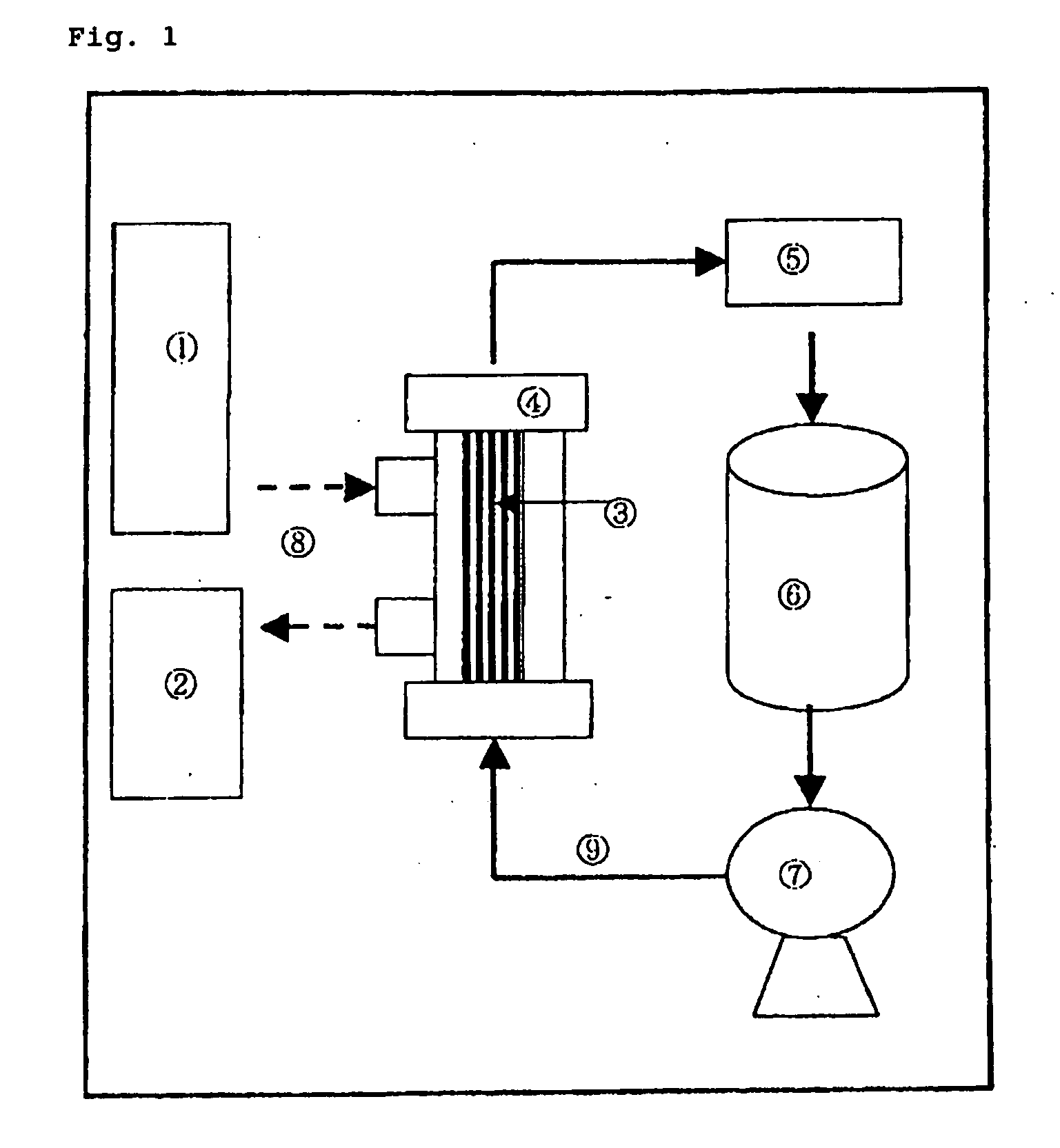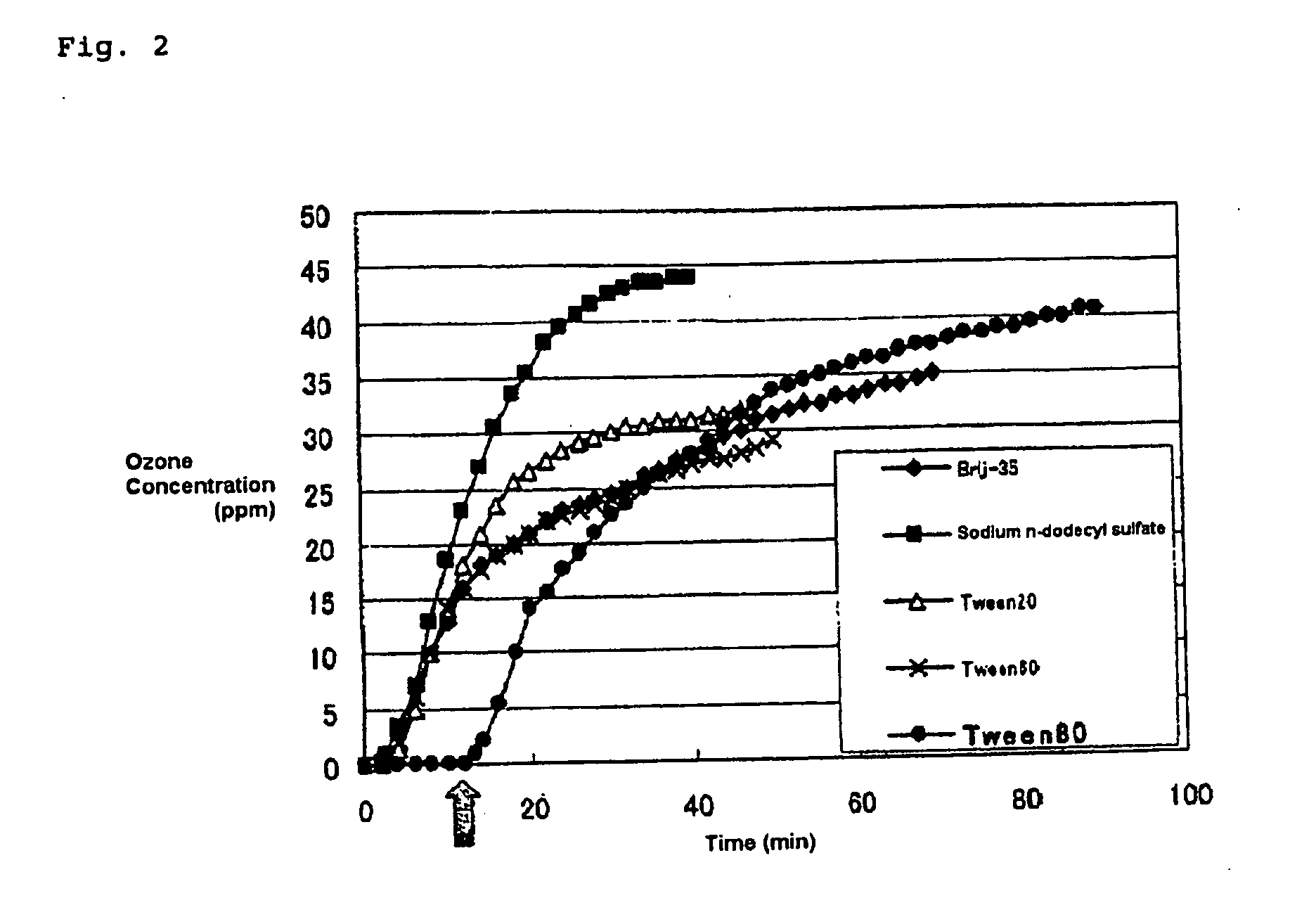Ozonized Surfactant
- Summary
- Abstract
- Description
- Claims
- Application Information
AI Technical Summary
Benefits of technology
Problems solved by technology
Method used
Image
Examples
example 1
[0080]An ozonized surfactant was synthesized according to a process flow shown in FIG. 1. More specifically, 2 L of a 0.1% aqueous solution of polyethylene glycol 20 sorbitan monooleate (Tween 80 manufactured by Wako Pure Chemical Industries, Ltd.) as a nonionic surfactant was charged into a cyclic reaction tank 6 made of PFA (a tetrafluoroethylene-perfluoroalkyl vinyl ether copolymer), supplied by a pump 7 into a dissolving hollow fiber membrane 3 in a module outer case 4, and sent back to the cyclic reaction tank 6 through an ozone detector 5 (ozone concentration meter EL-600 manufactured by EBARA Corporation).
[0081]Meanwhile, ozone gas was supplied from an oxygen cylinder into an ozonizer (ozonizer GR-RB manufactured by Sumitomo Precision Products Co., Ltd.) at an oxygen flow rate of 0.3 L / min to ozonize the oxygen to produce ozone gas. Then, the ozone gas was dissolved in the above-described aqueous solution in a dissolving module (SEK model manufactured by ERC Technology), and ...
example 2
[0082]Ozone treatment was carried out using the same system under the same conditions as in Example 1 except that instead of Tween 80, polyethylene glycol 20 oleyl ether (manufactured by Wako Pure Chemical Industries, Ltd.) was used. The concentration of ozone in the aqueous solution gradually increased after 16 minutes had elapsed, which confirmed that the reaction of ozone with unsaturated groups had been completed. Further, in 30 minutes, the concentration increased to 30 ppm. After deaerating the aqueous solution that had undergone about 30-minute ozone treatment to remove dissolved ozone gas by helium purging, oxidizing property of the aqueous solution was determined by the iodine titration method. As a result, the aqueous solution had oxidizing property, and frothing, which is a characteristic of surfactants, was observed. The results confirmed that ozonized polyethylene glycol 20 oleyl ether had been produced.
example 3
[0083]Ozone treatment was carried out using the same system under the same conditions as in Example 1 except that instead of Tween 80, polyethylene glycol 20 sorbitan trioleate (Tween 85 manufactured by Wako Pure Chemical Industries, Ltd.) was used as a nonionic surfactant. The concentration of ozone in the aqueous solution gradually increased after 22 minutes had elapsed, which confirmed that the reaction of ozone with unsaturated groups had been completed. After deaerating the aqueous solution that had undergone about 30-minute ozone treatment to remove dissolved ozone gas by helium purging, oxidizing property of the aqueous solution was determined by the iodine titration method. As a result, the aqueous solution had oxidizing property, and frothing, which is a characteristic of surfactants, was observed. The results confirmed that ozonized Tween 85 had been produced.
PUM
| Property | Measurement | Unit |
|---|---|---|
| Temperature | aaaaa | aaaaa |
| Temperature | aaaaa | aaaaa |
| Temperature | aaaaa | aaaaa |
Abstract
Description
Claims
Application Information
 Login to View More
Login to View More - R&D
- Intellectual Property
- Life Sciences
- Materials
- Tech Scout
- Unparalleled Data Quality
- Higher Quality Content
- 60% Fewer Hallucinations
Browse by: Latest US Patents, China's latest patents, Technical Efficacy Thesaurus, Application Domain, Technology Topic, Popular Technical Reports.
© 2025 PatSnap. All rights reserved.Legal|Privacy policy|Modern Slavery Act Transparency Statement|Sitemap|About US| Contact US: help@patsnap.com



